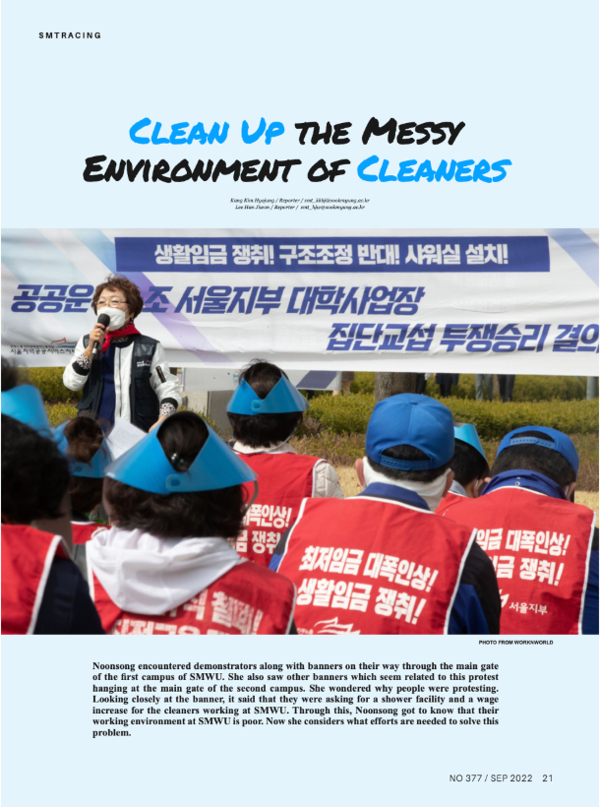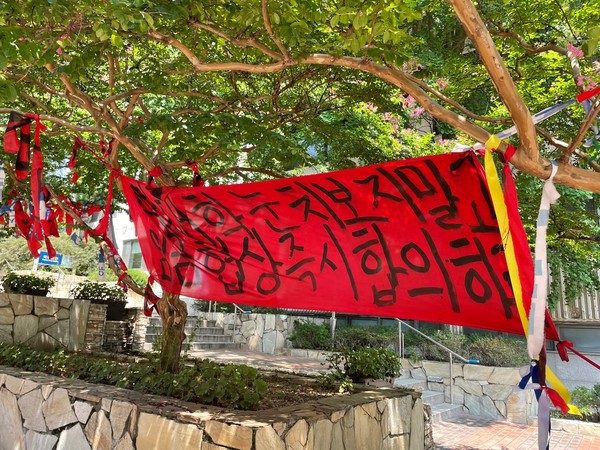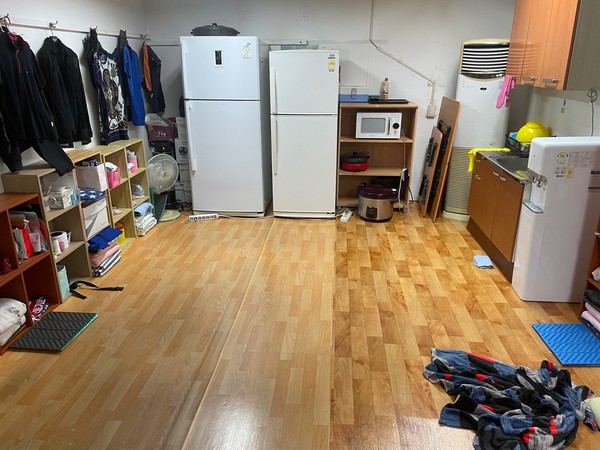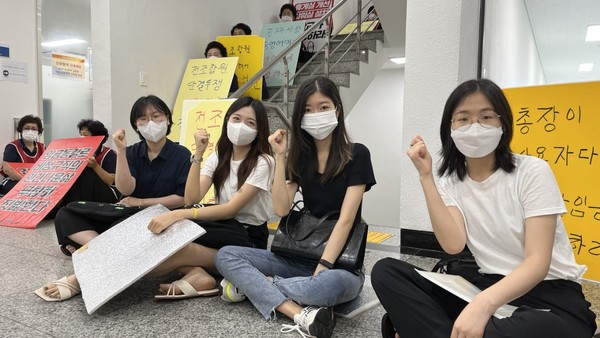
Noonsong encountered demonstrators along with banners on their way through the main gate of the first campus of SMWU. She also saw other banners which seem related to this protest hanging at the main gate of the second campus. She wondered why people were protesting. Looking closely at the banner, it said that they were asking for a shower facility and a wage increase for the cleaners working at SMWU. Through this, Noonsong got to know that their working environment at SMWU is poor. Now she considers what efforts are needed to solve this problem.

A chronic problem at SMWU
This year is not the first time that the cleaners on campus have demanded improvement in their working conditions. On September 24, 2015, about 100 cleaners and security workers working at SMWU held the inauguration of the labor union, demanding better working conditions in the Student Union Building of SMWU. As the demand for cleaners has continued for eight years until today, problems have been constantly raised. Especially, the demand for a wage increase at that time has been continuously requested. In May 2017, the cleaners held a rally in front of the Administration Building asking for an hourly wage increase, which is 150 won less than at other universities, for instance Sogang university, Hongik university, etc, and a total raise of 930 won an hour. At the time, they obtained a positive response. To reflect this demand, SMWU decided to raise the wages by 830 won and the subcontractor decided to raise by 100 won. Three months later, however, SMWU requested that the subcontractor pay 80 won out of the 830 won that SMWU was supposed to pay. Therefore, it was found that the university, which is the main contractor, is also involved in raising workers' wages. However, SMWU did not accept the demand of cleaners to raise the hourly wage by 130 won in 2021, saying that the finances were in a difficult state due to COVID-19.
In this situation, the cleaners are still demanding an hourly wage increase in 2022. SMWU paid wages of 9,260 won in 2020 and 9,390 won in 2021 when there were no face-to-face classes due to COVID-19. Therefore, SMWU has steadily increased the wages, indicating that they guaranteed an hourly wage of 670 won more than the minimum hourly wage of the year. Their hourly wage in 2022 is 9,390 won, 230 won more than the minimum hourly wage of 9,160 won this year. However, even though the minimum hourly wage rose by 440 won from 2021, the hourly wage for cleaners remains the same as last year. Therefore, the cleaners have demanded an increase in their wages of 400 won per hour, but SMWU considers it unacceptable. In addition to higher wages, they are also requesting improvements in their rest facilities. SMWU has one rest facility for each building, which is used by each building's cleaners. In some cases, up to 10 workers use it, so the cleaners are insisting on an expansion of the size of those places and an improvement of the poor environment. In addition, they emphasize the need for shower facilities. Currently, there are a total of eight on campus with four women's showers and four men's showers. Under these conditions, the cleaners want to improve the facilities they have been provided.

Asking parts of Sookmyung society about the problem
To investigate how much students know about the demonstration of the cleaners and what they think about it, this SMT surveyed Sookmyungians' awareness of it. In this survey, the labor conditions were divided into rest facilities, shower facilities, and wage increases. According to the survey, 209 out of 212 (98.6%) said they knew that the cleaners on campus had demonstrated this year.1) Therefore, most Sookmyungians have heard of the demonstration. When it comes to installing a rest facility for cleaners, 158 out of 204 (77.1%) who knew about it said that it is necessary that the size of the rest facilities be increased, and 132 (64.4%) said that the amount of the rest facilities is too low. In other words, more than half of the respondents think that the environment of the rest facility is substandard. On the other hand, some reasons the students thought it is not necessary were that the current number is appropriate or financially burdensome. Second, 175 out of 212 (82.5%) knew about the cleaners' request for shower facilities, and 190 out of 212 (89.6%) thought the installation of that facility is necessary. 180 out of that 190 (94.7%) said that the shower facility is necessary for their working conditions, followed by 109 (57.4%) that cited cleaners' hygiene. Conversely, seven people thought it is not important that there is not enough space to install more facilities on campus or that the cost of installation and water bills is required. Finally, 200 out of 212 (94.3%) knew that the cleaning workers had demanded a wage increase. Of the 194 (91.5%) who felt the need to raise wages, 139 (71.6%) said that the current wages did not match the labor intensity, and 161 (83%) said inflation should be considered. Two students who do not feel the need said that the wages are suitable for the labor intensity. Nevertheless, most students thought there should be an improvement in the working conditions of cleaning workers.
Based on students' thoughts, SMT surveyed whether students felt the need for the school to make an effort to improve the working conditions. Of the 212 respondents, 208 (98.1%) felt the need for school efforts in installing the rest facilities, 201 (94.8%) did in terms of wage increase and 200 (94.3%) did in terms of installing the shower facilities. Therefore, a majority of students think that the school's efforts are needed. This seems to be because students recognize cleaners as a part of Sookmyung. When it comes to why they thought so, 191 out of 209 (91.4%) said that their working rights should be protected, and 121 (57.9%) that the school indirectly employs the cleaners. In other words, the students consider the rights of workers important. In addition, the students think that even though the workers are included in the service enterprise, the school's efforts are needed as the main contractor. In contrast, there were concerns that it would be a burden on the school as well as reasons that the current working environment and the treatment of cleaners are appropriate to the answer that school efforts were not needed. At this point, SMT interviewed the cleaning workers on campus to get to know more about their working environment and tasks. According to one cleaning worker who uses a rest facility in Myungshin Building, "In the case of Myungshin Building and Saehim Hall, there is only one rest facility which is integrated, so it is too small for ten workers to rest together." Regarding this narrow space, she added, "When I go to the bathroom, I step on somebody." In this sense, the rest facility is insufficient in those buildings. Furthermore, another cleaning worker said, "Most workers begin work 1 to 2 hours early not to be pressed for time because each cleaner is assigned to clean all the classrooms, toilets, and professors' offices on one floor every day. However, no extra expenses have been paid for this." Through this, the degree of labor intensity is expected to be high.

From the office of General Affairs and Procurement
To answer students' questions about the treatment of the cleaners, SMT interviewed Cho Ohhyung, head of the office of General Affairs and Procurement at SMWU. SMT began the interview with questions related to the wages of cleaners. According to the survey, many students wondered why it was difficult for the school to accept the requirements of the cleaners. Therefore, SMT inquired about the difficulties which the school faces in negotiations with them. Cho said the reason is in the process of wage negotiations. To decide wages, universities receive the union's wage increase plan through the consignment company, and the universities deliver their opinion to the union through the consignee. In other words, negotiations between universities and unions do not proceed directly. In addition, it is also hard to reflect the request because if wages are determined first at one university, all universities have no choice but to follow. Next, SMT asked about the rest facilities of the cleaners. Cho replied that SMWU's rest facilities are all operated normally. Also, the Ministry of Employment and Labor found no cause for concern after an on-site investigation was conducted on the rest facilities. Nevertheless, to supplement the defects of the rest facilities, when complaints are received, the school checks and responds after consultation. For example, construction to improve the heating facilities on the lounge floor of the administration building were carried out, and air purifiers were installed throughout the underground rest facilities. On the other hand, he said it is not easy to set up additional shower rooms that the cleaners have demanded because structural changes are required to install waste-water facilities necessary for showers. To solve this problem, the relevant departments are discussing additional available spaces among the shower facilities around the school. Finally, he said he would try to find a deal quickly, asking to be excused for the damage caused by the delay in wage negotiations.
Aware of the seriousness of the treatment of cleaners, some students voluntarily gathered to form a Task Force (TF) team for the student union of workers on May 14. Therefore, SMT interviewed the TF team to find out more about the students who are trying to improve the treatment of the cleaners. The TF team consists of a large letterhead team, a banner team, and an accounting team, and they carry out activities such as raising funds, writing large letterheads, and posting them. On June 30, the team members joined a demonstration with the cleaners and expressed solidarity with them. Also, the TF team interviewed the union organization manager and cleaners and prepared a request that reflected their requirements. Based on this, they collected signatures from SMWU students and delivered the signatures and requests to the Office of the President. In addition, they proposed participation in the 'Joint Committee for Young Students to Solve the Problem of Indirect Employment of University Non-regular Workers.' This is a community where students who are in solidarity with school workers can gather to take part in solidarity activities. Through participation, they can join up with other schools as well as SMWU. In an interview with SMT, the TF team emphasized the importance of students' continued interest in improving the treatment of the cleaners. The TF team members said they felt that continuous solidarity was most important when they were told that "students cheer us up when they are with us." It is a great help for them to participate in the activities, and the TF team said, "Please pay a lot of attention to the news about cleaners' demonstrations and TF activities in the school." Therefore, students' support of the cleaners is most important to make improvements to their working conditions.

Co-existence with university and cleaners
From May 2015 until now, cleaners have been protesting. They are demanding better working conditions, including wage increases and improvement of rest facilities. However, the university said that the rest facilities on campus are already above the legal standards, so it is difficult to meet all their requests. Universities are trying to come up with various measures to improve their cleaners' working conditions. In this regard, SMWU is also making efforts to improve the cleaners' working environment and students are also setting up TF teams to help them. Since these efforts stem from the perception that cleaners who work at SMWU are also members of SMWU, the university also needs to make more positive changes about the working environment of cleaners with this perception.
1) The total number of students enrolled is 12,249, with a survey participation rate of about 1.7%
Kang Kim Hyojung / Reporter
smt_kkhj@sookmyung.ac.kr
Lee Han Jiwon / Reporter
smt_hjw@sookmyung.ac.kr


